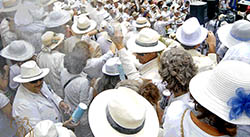‘It’s a pala,’ said J, sitting up. A pala is a spade or a shovel but in this part of the world it’s also a mechanical digger, an excavator. Palas come in various sizes but they are always yellow and they are always Japanese.
Beep-beep-beep! - reversing to attack from a different angle. The cacophony of sounds made by a pala is unmistakeable. It’s not unusual to hear one working early in the morning but usually they’re down in the valley. The council sends them to clear the access road after rain has loosened rocks from the slopes. Occasionally a pala will spend a day or more levelling the dry river bed to form a temporary car park for a village fiesta, which is one of its more exciting tasks.
We also hear them working further away, across the valley or up the hill. Palas have multiple uses depending on what’s fixed to the end of their big yellow elbow, from cutting narrow trenches in roads to re-profiling the sand on the beaches or breaking up large rocks into smaller ones. As a friend once remarked, Gomera wouldn’t be Gomera without the palas.
Palas are also heavily involved in tearing down old buildings, but not usually this close to our house. In the clear air of early morning it sounded like an army demolition team clearing our neighbours’ homes out of the way in order to reach us – there they are, they won’t get away! Had we forgotten to pay this year’s Property Tax? Still in my pyjamas I peered out of the back door. I could see a monstrous yellow elbow rising and falling, a really big one. It was destroying Vicente’s old farm cottage, tugging rocks from the top of its walls. The roof was already gone.
We knew this was going to happen but it was still shocking to watch. This was part of my life being torn down. We often used to chat to Vicente in our early years when we came only for the winter months and he always greeted us on arrival with the same question: ‘When are you going home?’ What he really meant, I hope, was ‘How long are you staying?’ This is the kind of innocent misunderstanding that can cause people to post vitriolic reviews about their holiday hotel after a brief exchange with a cleaner.
Vicente was gone now and his widow had moved away to live with their daughter. The family had decided to clear the land and build a new house, perhaps two. I showed one of his sons a photograph I took years ago of Vicente sitting on a bucket surrounded by his chickens and turkeys and goats, laughing happily at the camera. His son smiled at the photo and told me he’d already got a copy, found among his dad’s possessions.
Watching the pala biting chunks out of the building that used to be the goatshed, then later razing the old house itself, I couldn’t help feeling sad. A treacherous little voice inside my head was playing the role of concerned foreigner poking his nose in where it didn’t belong – cultural vandalism! History being destroyed before our very eyes! Someone could have turned that into a charming old cottage! – but I didn’t listen. I’d got over all that many years ago when, talking to another neighbour, he told us with great pride that there were now only five old cottages left in the village. All those humble old hovels were disappearing one by one to be replaced by smart, modern buildings with proper kitchens and bathrooms. I’d decided he was right.
The sound of a pala, in other words, is the sound of progress. This is not something to be regretted, it’s to be welcomed as not only inevitable but good!
Up to a certain point, of course. The rash of air conditioning fans spreading across walls here, as in the rest of the world, is not good at all, it’s bad, bad, bad. Climate change! There are so many better ways to…
Sorry?
Okay, you’re right. Stick with the message. Progress is good. Except…


















